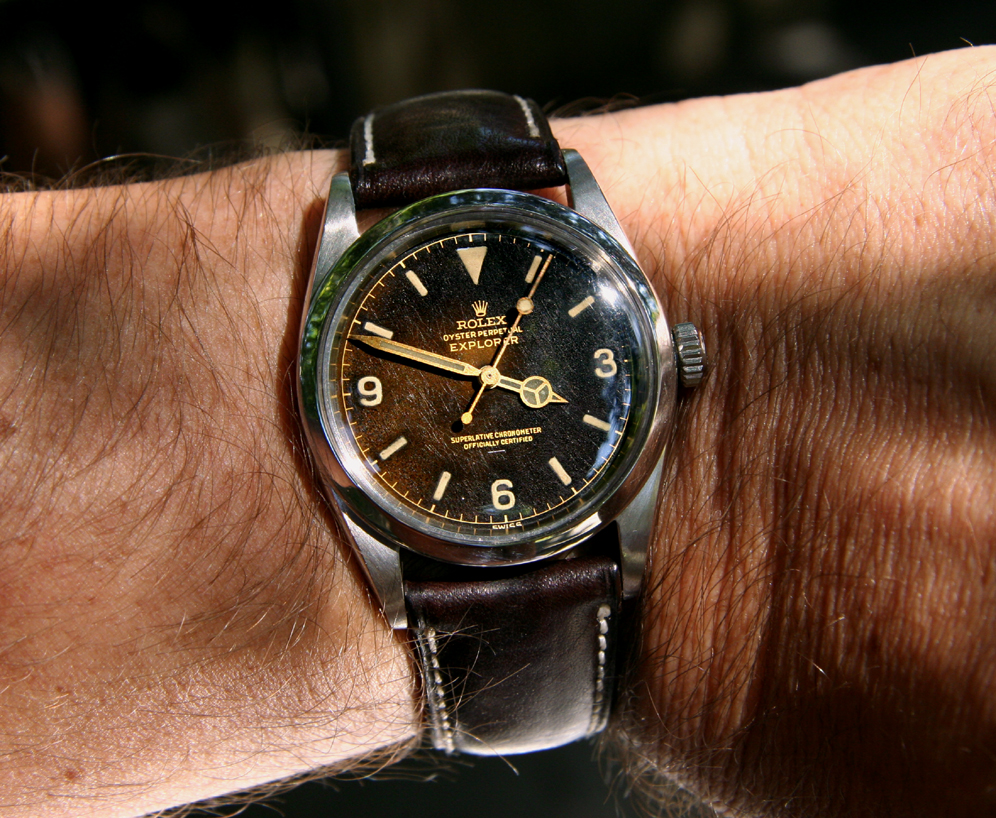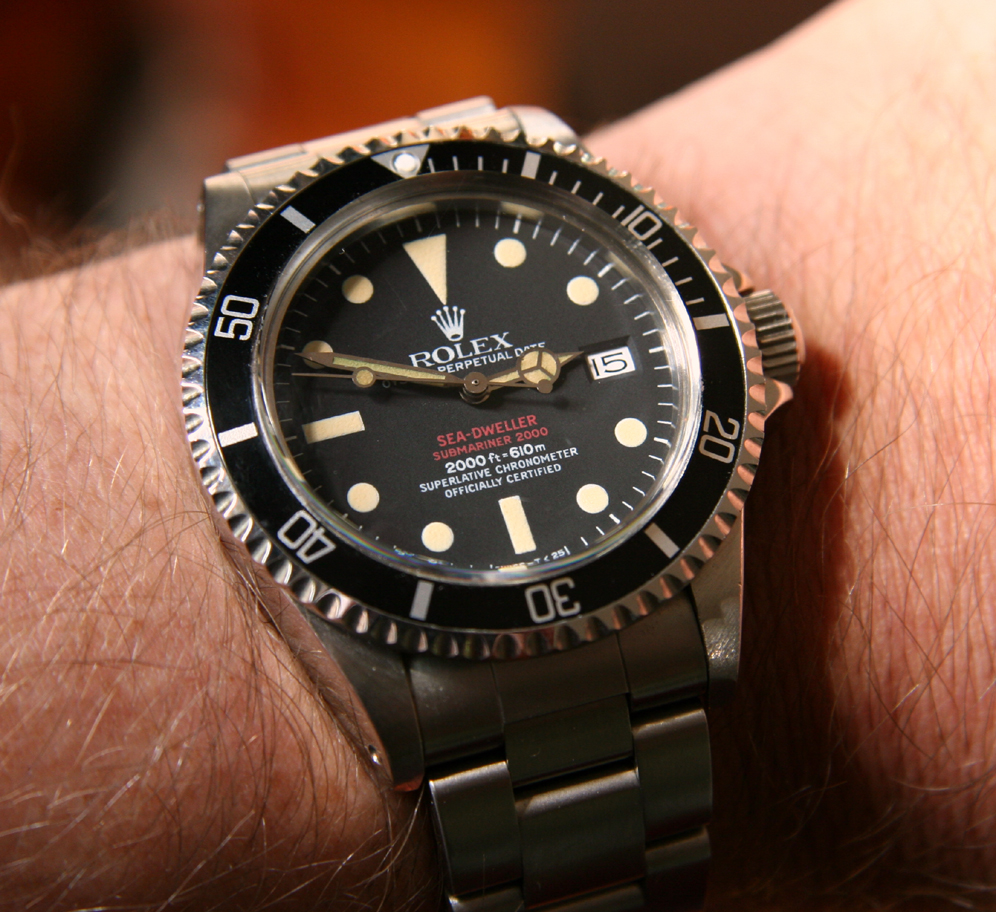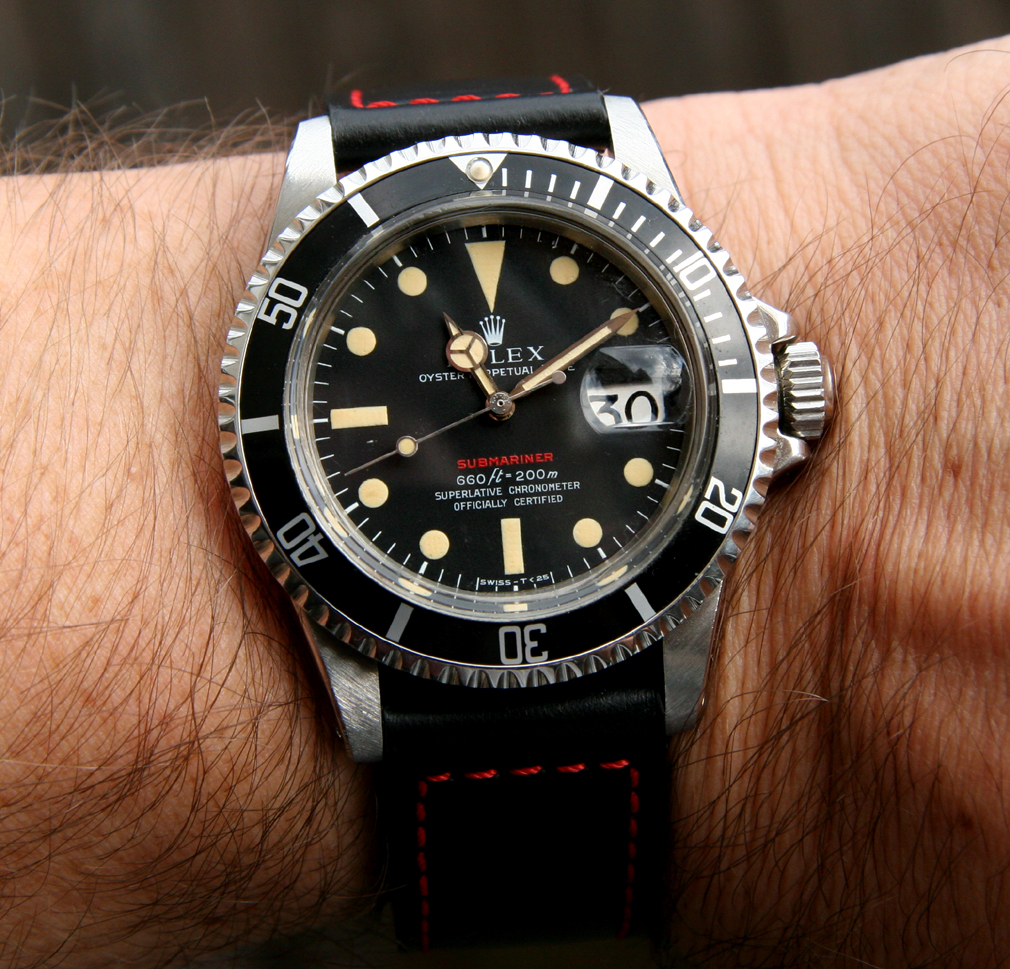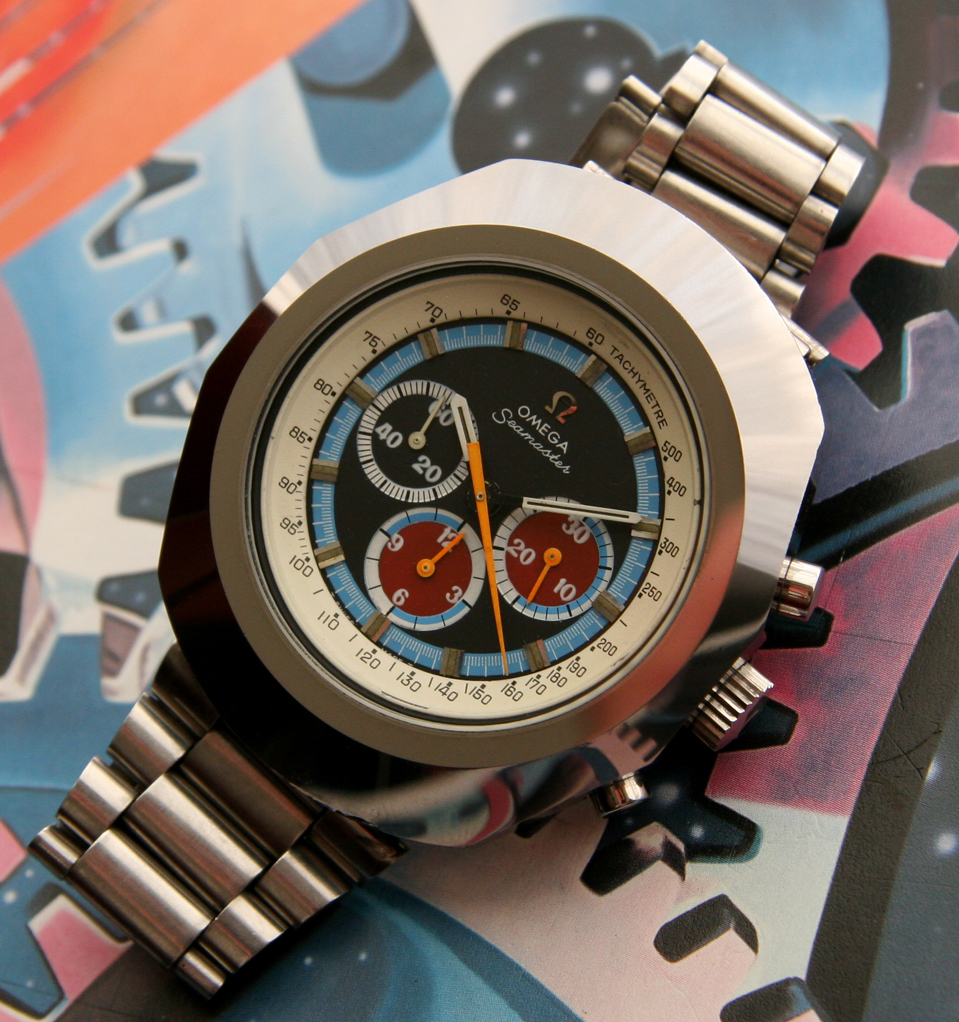Perhaps the best part of collecting vintage watches is that you get to wear them. They can augment your look, make you feel like a million bucks and express your unique personal aesthetic. Whether you are a one watch kind of guy or a polygamous collector like yours truly, odds are you will find more personal expression in a vintage piece that you have had to learn about, hunt and capture than something you can just walk into a retail store and buy brand new. Not that there’s anything wrong with a new watch and for some the risks of a vintage piece may outweigh the rewards. But once you strap on an older watch that displays its subtle out-of-time qualities so attractively–its years of use, its patina, its wabi-sabi–I think you’ll see the attraction.
 Gilt Explorer ref. 1016, ca. 1963
Gilt Explorer ref. 1016, ca. 1963
And, while I definitely wear all of my vintage watches, there is arguably no better vintage watch to wear on a daily basis than a Rolex Oyster. This may sound like snobbery but in fact what I’m talking about here is toughness and suitability to the demands of day-to-day activities and exertions.
Because the Rolex Oyster is usually constructed out of a 3-piece case–press on bezel securing the crystal, stout mid case and screwed on back with gasket, as well as screw down crown–it is inherently water resistant. While other brands’ “special” models may have features like a screw down crown, screwed back or separate bezel/crystal retaining ring, virtually all Oysters after the 1950s have this as part of their DNA (earlier Oysters were often produced with a cosmetic or formed bezel but, with rare exceptions, still always had the screw down crown and back). In fact, I would say that the reason one sees so many old Rolex Oysters in good condition across all model lines is that these babies were built to last right from the start. Water is a watch killer and it is simply a fact that until at least the late 1970s, Rolex were the only marque making superior water resistance a standardized feature across their entire Oyster line, from the ladies’ models to the Sea-Dweller, and with the most lasting and foolproof case construction techniques to achieve it.
 Double Red Sea-Dweller ref. 1665, ca. 1972
Double Red Sea-Dweller ref. 1665, ca. 1972
Another plus is that Rolex’s style has always remained relatively conservative, as I brought up in my last post, so that a modern Submariner still looks similar to the originals produced 60 years ago. Not the same, mind you, but similar. This means both that an old Rolex never really goes out of style and also that an old Rolex has a antiquated elan that the modern version will not possess. In the same way that a 1968 Porsche 911 might be no match technically for a modern 911 yet is still infinitely cooler to admire and drive, a sweet old Red Sub beats the pants off the modern version in my book any day. New and shiny and technologically cutting edge floats some guys’ boats. I get that. But I’ll take something classic and clean from the past with a personality forged by the years 9 times out of 10. Old machines–cameras, cars, watches–simply have a charm that I feel is hard to find in their modern counterparts. You can call it nostalgia but I’d call it more of a intangible feeling, an experience of the continuity of time that stretches from the 40-year-old watch on your wrist to right now and all the times in between.
 Red Submariner ref. 1680, ca. 1972
Red Submariner ref. 1680, ca. 1972
But the key benefit of Rolex’s very cautious approach to changes over the years is that their watches are now design classics. You can call it boring or hold their supposed stodginess against them but everyone knows the look of the Submariner, the GMT-Master, the Datejust, etc, by the very fact that they have remained relatively constant. By generally not chasing the latest fads in Geneva or fashion trends sweeping the world (at least in the past), Rolex did not fall into the trap of manufacturing watches that are redolent of a certain era. For example, I love 70s watches–big, chunky, funky–and probably the main pursuer of 70s style in the watch world was Omega, with their wonderful tonneau cased Speedmaster Mark II & III, Flightmaster, Speedsonic and Memomatic lines, as well as square shaped Constellations and Seamasters galore. As I say, I love these watches and when I want to get down and get funky, I strap one on. But these watches are statement watches–retro, disco, macho, funky, far out. When I want my watch to blend in with my outfit and just be it’s going to be a Rolex from the 50s, 60s, 70s or whenever–whatever fits the mood, I’ll find one that does. An Explorer from the 70s does not make a 1970s statement. Neither does a Sub. The point being that if I am dressed up super nice for work or play, I am probably not going to strap on a big honking brightly colored 70s Omega but rather go with an appropriate vintage Rolex. (If I did want a Rolex that makes a 70s statement, it would have to be the “Disco Ball” Explorer II, an uncharacteristic and unsuccessful-at-the-time concession to the prevailing fashion trends. Today, it’s a cult classic.)
 Omega Seamaster “Anakin” Chronograph, ca. 1969
Omega Seamaster “Anakin” Chronograph, ca. 1969
 Explorer II ref. 1655, ca. 1971
Explorer II ref. 1655, ca. 1971
Which brings me to the last of my points about the eminent wearability of Rolex’s vintage watches: versatility. Because of the much more relaxed, mix-and-match world of men’s fashion that we live in today, you can wear what used to be considered taboo watches with nearly all of your finest clothes. While you may want to leave wearing a Submariner with a tux to Commander Bond, a Sub with a suit is definitely A-OK nowadays. You see it all the time. Heck, Brian Williams regularly wears modern GMT-Masters and Daytonas while he’s delivering the nightly news on NBC in a natty outfit and no one would accuse him of being a radical fashionista. And the flipside is also true–you can wear a nice gold or two-tone Datejust with your favorite pair of jeans and concert T. Rolex lends itself to just that sort of yin yang, playing with their classy image in either direction, and because they somewhat pioneered the oversize watch, a great many of their older timepieces stand up well to today’s big watch standards. Back in the day a 40mm Submariner or GMT was considered quite large and the dress size of 36mm for the Datejust and Day-Date line was thought to be at just about the outer limit for elegance, especially with such thick cases. Of course, they aren’t considered particularly large anymore among all the Panerais and Breitlings. But they’re plenty big enough to stand out on a gentleman’s wrist at work or play. And when the pendulum swings back to less gargantuan sizes, as it inevitably will, vintage Rolex will remain what it always has been: a classic lifestyle statement suitable for nearly any occasion as well as the day-to-day rigors of a man’s fine and demanding life.

